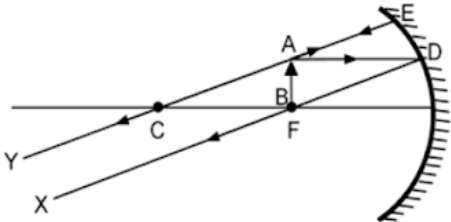
When an object is placed at the focus of the concave mirror:
a) Image formed is at infinity
b) Image is highly magnified
c) Image is real and inverted
Mark the correct statements:
A) a, b
B) b, c
C) a, c
D) a, b, c
Answer
216.3k+ views
Hint: You need to recall the case of a concave mirror where the object is placed at focus of the mirror. Recall all the laws of reflection for a concave mirror, how a ray of light propagates after reflection from the mirror and trace the ray diagram for the condition given in the question i.e. when the object is at focus; and you will get your answer.
Complete Step by Step Answer:
The ray diagrams of mirrors are not like that of lenses. In lenses, the rays used to pass directly from the lens. But in mirrors, the ray will be reflected back to the same side of the mirror from where it was coming.
Concave mirror is a special kind of mirror, not like the plane mirrors we use at our homes. Concave mirrors are curved and hence, their laws of reflection are also different from plane mirrors.
Keeping the laws of reflection in a concave mirror in mind, we will now draw the ray diagram for a concave mirror when the object is at focus.

As we can see, the image will be formed at infinity. Hence, point a is correct.
Since, the image is formed at infinity, it will be highly magnified. Hence, point b is also correct.
Also, we can see that the rays will meet below the principal focus and on the same side of the mirror as the object. Which implies that the image will be real and inverted. Hence, point c is also correct.
Therefore, option (D) is the correct answer.
Note: The rays parallel to the principal axis pass through focus after reflection. The rays passing through the center of curvature traces the same path after reflection. The concave mirror is a converging mirror and hence, the rays actually meet each other after getting reflected. However, the convex mirror is a diverging mirror, it diverges the light rays incident on it. So, we assume these diverged reflected rays meet at a point behind the mirror. So, in the case of convex mirrors we only get virtual images.
Complete Step by Step Answer:
The ray diagrams of mirrors are not like that of lenses. In lenses, the rays used to pass directly from the lens. But in mirrors, the ray will be reflected back to the same side of the mirror from where it was coming.
Concave mirror is a special kind of mirror, not like the plane mirrors we use at our homes. Concave mirrors are curved and hence, their laws of reflection are also different from plane mirrors.
Keeping the laws of reflection in a concave mirror in mind, we will now draw the ray diagram for a concave mirror when the object is at focus.

As we can see, the image will be formed at infinity. Hence, point a is correct.
Since, the image is formed at infinity, it will be highly magnified. Hence, point b is also correct.
Also, we can see that the rays will meet below the principal focus and on the same side of the mirror as the object. Which implies that the image will be real and inverted. Hence, point c is also correct.
Therefore, option (D) is the correct answer.
Note: The rays parallel to the principal axis pass through focus after reflection. The rays passing through the center of curvature traces the same path after reflection. The concave mirror is a converging mirror and hence, the rays actually meet each other after getting reflected. However, the convex mirror is a diverging mirror, it diverges the light rays incident on it. So, we assume these diverged reflected rays meet at a point behind the mirror. So, in the case of convex mirrors we only get virtual images.
Recently Updated Pages
Wheatstone Bridge Explained: Working, Formula & Uses

Young’s Double Slit Experiment Derivation Explained

JEE Atomic Structure and Chemical Bonding important Concepts and Tips

JEE Amino Acids and Peptides Important Concepts and Tips for Exam Preparation

Electricity and Magnetism Explained: Key Concepts & Applications

Chemical Properties of Hydrogen - Important Concepts for JEE Exam Preparation

Trending doubts
JEE Main 2026: Application Form Open, Exam Dates, Syllabus, Eligibility & Question Papers

Derivation of Equation of Trajectory Explained for Students

Hybridisation in Chemistry – Concept, Types & Applications

Understanding the Angle of Deviation in a Prism

Understanding Collisions: Types and Examples for Students

How to Convert a Galvanometer into an Ammeter or Voltmeter

Other Pages
JEE Advanced Marks vs Ranks 2025: Understanding Category-wise Qualifying Marks and Previous Year Cut-offs

Ideal and Non-Ideal Solutions Explained for Class 12 Chemistry

Degree of Dissociation: Meaning, Formula, Calculation & Uses

Understanding Electromagnetic Waves and Their Importance

Understanding the Electric Field of a Uniformly Charged Ring

Understanding Average and RMS Value in Electrical Circuits




